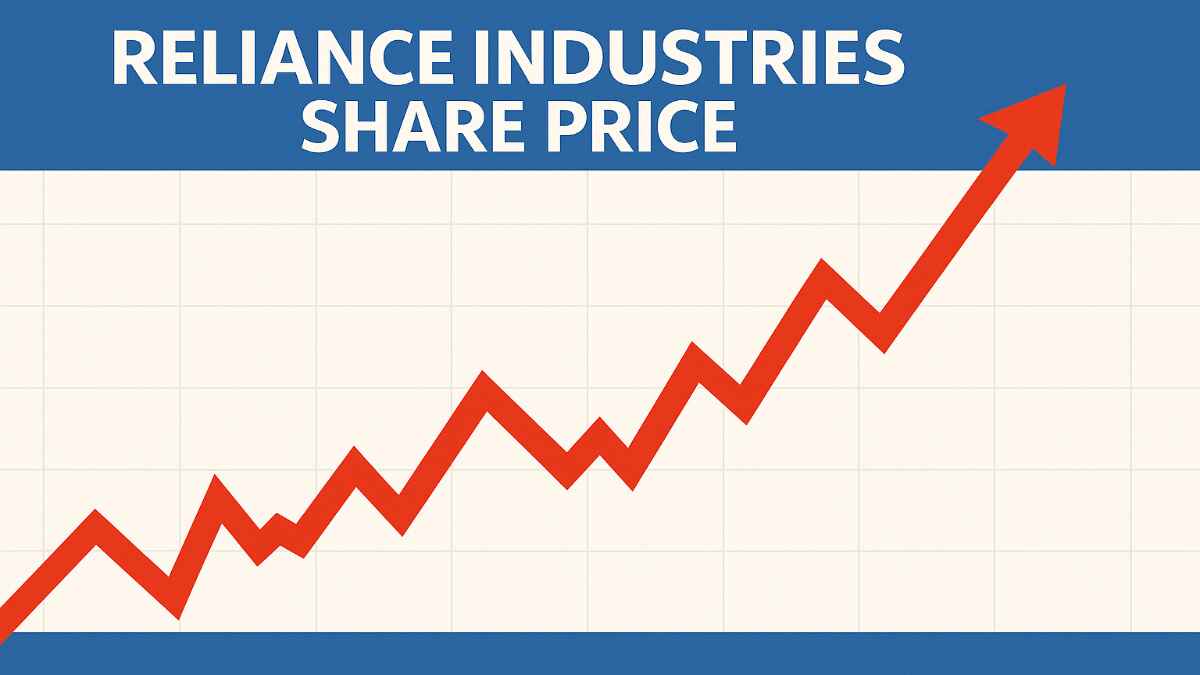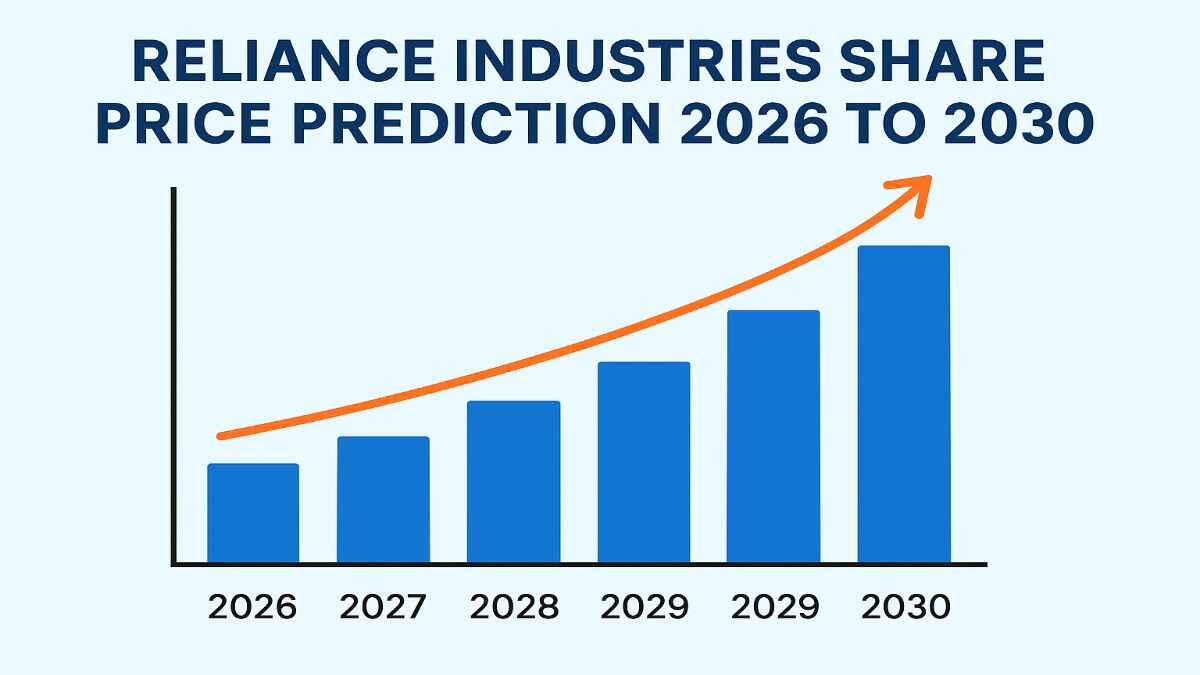Reliance Industries Limited (RIL), founded by Dhirubhai Ambani and now led by Mukesh Ambani, is a cornerstone of India’s economy. With a diverse portfolio spanning oil-to-chemicals (O2C), retail, digital services, oil and gas, and emerging sectors like renewable energy and aerospace, Reliance is a powerhouse that attracts significant investor interest. As of mid-2025, its market capitalization stands at approximately ₹19,08,213 crore, making it one of India’s most valuable companies. For investors, the Reliance Industries share price prediction 2026 to 2030 is a critical topic, as it offers insights into the company’s future growth potential.
Table of Contents
Introduction to Reliance Industries
Reliance Industries has transformed from a textile and petrochemical company into a global conglomerate with interests in multiple high-growth sectors. Its flagship businesses include:
- Oil-to-Chemicals (O2C): Encompassing petroleum refining and petrochemicals, contributing over 50% of revenue.
- Retail: Through Reliance Retail, the largest organized retailer in India.
- Digital Services: Led by Jio, a leader in telecommunications and digital innovation.
- Oil and Gas: Focused on exploration and production.
- Others: Including new ventures in renewable energy, aerospace, and media.
The company’s ability to adapt to changing market dynamics and invest in future-ready sectors makes it a compelling investment option. However, predicting the Reliance Industries share price prediction 2026 to 2030 requires understanding its past performance, current financial health, and external factors like economic conditions and industry trends. This article aims to provide a clear and balanced outlook for investors.
Historical Performance of Reliance Industries
To understand the Reliance Industries share price prediction 2026 to 2030, it’s essential to look at its historical performance. Over the past decade, Reliance’s share price has shown significant growth, driven by strategic expansions and market leadership:
- 2015: The share price was around ₹700, primarily driven by its core O2C business.
- 2020: The price surged to over ₹1,500, fueled by the success of Jio and Reliance Retail, along with significant investments from global players like Facebook and Google.
- 2025: As of mid-2025, the share price fluctuates between ₹1,400 and ₹1,500, reflecting market volatility but also resilience.
Key milestones that boosted the share price include:
- Launch of Jio (2016): Disrupted the telecom sector with affordable data plans, leading to rapid subscriber growth.
- Retail Expansion: Acquisitions like Future Group’s retail assets strengthened Reliance Retail’s market dominance.
- Fundraising in 2020: Raised over ₹1.5 lakh crore through stake sales in Jio Platforms and Reliance Retail, boosting investor confidence.
Despite challenges like the COVID-19 pandemic and oil price volatility, Reliance’s diversified portfolio has helped it maintain steady growth. This historical context sets the stage for understanding the Reliance Industries share price prediction 2026 to 2030.
Current Market Conditions
As of July 31, 2025, Reliance Industries’ share price is trading in the range of ₹1,400 to ₹1,500, according to sources like Moneycontrol. The company’s recent financial performance highlights its strength:
- Q4FY25 Results: Revenue grew by 10% year-over-year (YoY) to ₹261,388 crore, and net profit increased by 7% YoY to ₹22,611 crore, as reported by Trade Brains.
- Segment Contributions:
- O2C: 51.36% of revenue (₹1,64,613 crore)
- Retail: 28% (₹88,637 crore)
- Digital Services: 13% (₹40,861 crore)
- Oil and Gas: 2% (₹6,440 crore)
- Others: 6.2% (₹19,920 crore)
Reliance’s financial health is robust, with AAA credit ratings from CRISIL and Fitch, and investment-grade ratings from Moody’s (Baa2) and S&P (BBB+), as noted on Wikipedia. Recent developments, such as the expansion of polyester capacity and a ₹60–65,000 crore PVC project, signal strong growth prospects. However, challenges like EU sanctions and weakness in the oil and retail sectors have caused short-term price dips, as reported by Indmoney.
Factors Influencing Reliance Industries Share Price
Several factors will shape the Reliance Industries share price prediction 2026 to 2030:
1. Oil and Gas Prices
The O2C segment, which includes refining and petrochemicals, is highly sensitive to global oil prices. Higher oil prices can boost refining margins but may increase input costs for petrochemicals. Volatility in this sector could impact overall profitability.
2. Retail Expansion
Reliance Retail is India’s largest organized retailer, with a growing presence in grocery, fashion, and electronics. Its omnichannel strategy and acquisitions position it for continued growth, which could positively influence the share price.
3. Digital Services Growth
Jio’s leadership in telecommunications, coupled with its expansion into 5G and broadband, makes it a key growth driver. The increasing adoption of digital services in India, driven by rising smartphone penetration, supports this segment’s potential.
4. Economic Conditions
India’s economic growth, inflation rates, and interest rates will affect consumer spending, impacting Reliance’s retail and digital services segments. A strong economy with stable inflation is favorable for sustained growth.
5. Regulatory Environment
Government policies, particularly in the oil and gas sector, can create opportunities or challenges. For example, incentives for renewable energy could benefit Reliance’s new ventures, while stricter regulations could pose risks.
6. Strategic Initiatives
Reliance is investing in high-growth areas like renewable energy, aerospace, and media. Projects like the ₹75,000 crore O2C capex plan and the PVC facility, set to be commissioned by 2026–27, could drive long-term value.
Expert Predictions for Reliance Industries Share Price 2026 to 2030

Analysts have provided varied forecasts for the Reliance Industries share price prediction 2026 to 2030, reflecting different methodologies and assumptions. Below is a summary of key predictions:
| Year | Source | Minimum Price (₹) | Maximum Price (₹) | Average Price (₹) |
|---|---|---|---|---|
| 2026 | Exla Resources | 3,450 | 3,800 | 3,625 |
| 2026 | Traders Union | – | – | 1,587.42 |
| 2026 | Figw.in | 1,519.29 | 2,091.55 | 1,789 |
| 2027 | Exla Resources | 3,810 | 4,150 | 3,980 |
| 2027 | Traders Union | – | – | 1,726.03 |
| 2027 | Figw.in | 1,910.60 | 2,425.32 | 2,176.85 |
| 2028 | Exla Resources | 4,100 | 4,300 | 4,200 |
| 2028 | Traders Union | – | – | 1,876.75 |
| 2028 | Figw.in | 1,892.14 | 2,540.37 | 2,115.30 |
| 2029 | Exla Resources | 4,320 | 4,650 | 4,485 |
| 2029 | Traders Union | – | – | 2,040.62 |
| 2029 | Figw.in | 2,507.20 | 2,787.72 | 2,636.10 |
| 2030 | Exla Resources | 4,680 | 5,000 | 4,840 |
| 2030 | Traders Union | – | – | 2,218.77 |
| 2030 | Figw.in | 2,831.78 | 3,545.20 | 3,253.80 |
Analysis of Predictions
- Exla Resources (Exla Resources): Highly optimistic, predicting a steady rise to ₹5,000 by 2030, driven by strong growth across all segments.
- Traders Union (Traders Union): More conservative, forecasting a price of ₹2,218.77 by 2030, possibly due to cautious assumptions about oil prices and economic conditions.
- Figw.in (Figw.in): Offers a balanced outlook, with an average price of ₹3,253.80 by 2030, reflecting moderate growth expectations.
Short-term analyst consensus, as reported by Trendlyne, suggests a price target of ₹1,562 to ₹1,634 for FY26, indicating a potential upside from the current price. However, some sources like Wallet Investor are bearish, predicting a decline to ₹1,326.226, citing a negative trend in the energy sector.
Potential Risks and Opportunities
Risks
- Oil Price Volatility: The O2C segment’s reliance on global oil prices introduces uncertainty. A prolonged period of low prices could hurt profitability.
- Regulatory Changes: Stricter regulations in the oil and gas or telecom sectors could increase costs or limit growth.
- Competition: Intense competition in retail and telecom from players like Amazon, Flipkart, and Airtel could challenge market share.
- Economic Slowdown: A weaker Indian economy could reduce consumer spending, impacting retail and digital services.
Opportunities
- Retail Growth: Reliance Retail’s omnichannel strategy and expansion into new categories position it for market leadership.
- Digital Services: Jio’s 5G rollout and broadband expansion could capture a larger share of India’s growing digital market.
- New Ventures: Investments in renewable energy, aerospace, and media could diversify revenue streams and drive long-term growth.
- Global Expansion: Reliance’s strong credit ratings and financial health enable it to explore international opportunities.
FAQs
What is the current share price of Reliance Industries?
As of July 31, 2025, the share price is approximately ₹1,400 to ₹1,500, based on data from Moneycontrol.
What are the main business segments of Reliance Industries?
Reliance operates in Oil-to-Chemicals (O2C), Retail, Digital Services, Oil and Gas, and Others, including renewable energy and media.
How has Reliance Industries performed financially in recent quarters?
In Q4FY25, revenue grew by 10% YoY to ₹261,388 crore, and net profit increased by 7% YoY to ₹22,611 crore, as per Trade Brains.
What are the long-term growth prospects for Reliance Industries?
Reliance’s investments in polyester capacity, a PVC project, and emerging sectors like renewable energy and aerospace suggest strong growth potential.
Is Reliance Industries a good investment for the long term?
While forecasts vary, Reliance’s diversified portfolio and strategic initiatives make it an attractive option. However, investors should consider risks like oil price volatility and competition.
What factors could drive the share price higher by 2030?
Growth in retail, digital services, and new ventures, along with favorable economic conditions, could push the share price upward.
What are the risks of investing in Reliance Industries?
Key risks include oil price fluctuations, regulatory changes, and competition in retail and telecom.
Conclusion
The Reliance Industries share price prediction 2026 to 2030 is a topic of great interest due to the company’s dominant position in India’s economy. Expert forecasts range from a conservative ₹2,218.77 (Traders Union) to an optimistic ₹5,000 (Exla Resources) by 2030, reflecting diverse views on its growth potential. Factors like oil prices, retail expansion, digital services growth, and economic conditions will play a crucial role. While Reliance’s strong financials, strategic investments, and diversified portfolio suggest a promising future, investors should remain mindful of risks like market volatility and competition. By staying informed and consulting financial advisors, investors can make well-informed decisions about the Reliance Industries share price prediction 2026 to 2030.
Disclaimer: Moneyjack.in provides general financial information for educational purposes only. We are not financial advisors. Content is not personalized advice. Consult a qualified professional before making financial decisions. We are not liable for any losses or damages arising from the use of our content. Always conduct your own research.
